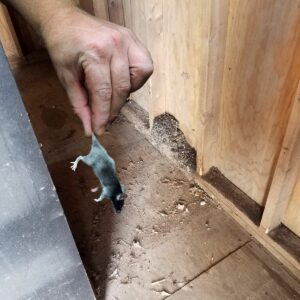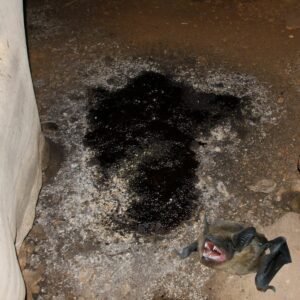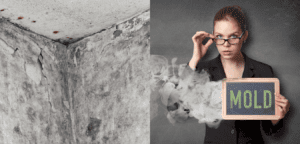Bat Guano vs Mouse Feces
Droppings from small mammals such as rodents and bats can look similar to homeowners. Pest control methods become more challenging when it is not clear what type of critter has infested your home. It is important to determine which type of dropping is in your home so that you can safely get rid of the unwanted guest. Below is some information that you may find helpful in determining which kind of dropping is in your house.
 Also referred to as guano or scat, mouse droppings, and bat droppings are black in color. Mice pellets are oblong in shape and found in scattered patterns throughout infested homes, such as the basement, kitchen, and garage. One or two pointy ends are commonly found alongside rodent hairs in excrement. Old droppings have a hard, dull appearance, while fresh ones appear shiny. Furthermore, they are usually around 1/8 to 1/4 inch in size.
Also referred to as guano or scat, mouse droppings, and bat droppings are black in color. Mice pellets are oblong in shape and found in scattered patterns throughout infested homes, such as the basement, kitchen, and garage. One or two pointy ends are commonly found alongside rodent hairs in excrement. Old droppings have a hard, dull appearance, while fresh ones appear shiny. Furthermore, they are usually around 1/8 to 1/4 inch in size.
At first glance, bat droppings may appear similar to mouse excrement. However, closer inspection reveals distinct differences. A bat’s droppings are larger than mouse droppings. They are about 1/4 to half an inch long. Furthermore, it appears in clusters near the bat’s nests rather than randomly scattered. Due to the presence of insects in bat droppings, their texture is rough. They often have blunt ends instead of pointed ones, and the remains of insects tend to be visible.
Bat Guano
Bats are beneficial creatures that are known for controlling insects naturally. There are many reasons why bats that roost near humans pose a problem. Rabid bats can inflict costly repairs and cleanup, are intimidating to people when living with them, and the guano they leave behind is one of their most overlooked dangers.
Bat Guano
 According to the CDC, Histoplasmosis is a disease caused by bat droppings known as guano. Those with a weakened immune system are more at risk since this disease predominantly affects the lungs. Bird and bat droppings carry spores that are transmitted when a person inhales them.
According to the CDC, Histoplasmosis is a disease caused by bat droppings known as guano. Those with a weakened immune system are more at risk since this disease predominantly affects the lungs. Bird and bat droppings carry spores that are transmitted when a person inhales them.
Symptoms of histoplasmosis include:
- Fever
- Cough
- Fatigue (extreme tiredness)
- Chills
- Headache
- Chest pain
- Body aches
After breathing in the fungus, these symptoms typically appear between three and seventeen days later. There can be delays in diagnosis and treatment due to the similarity of symptoms to other conditions.
Histoplasmosis can be severe in some people. People who are ill or who take medications that impede the body’s ability to fight germs (or those with compromised immune systems), as well as those who are in contact with a lot of fungi, are at a higher risk. If the infection is severe, prescription antifungal medicine must be taken.
However, most people who breathe in the fungus that causes histoplasmosis do not experience symptoms, or experience only mild symptoms. Often, people don’t realize they have histoplasmosis until they have a CT scan, X-ray, or other imaging test showing them spots on their lungs. They may look similar to lung cancer, causing unnecessary costs and psychological stress to find the right diagnosis.
Removal Of Bat Guano
This involves working at close range to a bat population and using nets to catch bats leaving the structure. Also, exclusion work is necessary to ensure that the bats do not return. There is a risk of diseases such as rabies and histoplasmosis if you work with bats, so we obviously recommend leaving it to trained professionals.
A typical homeowner will have a difficult time handling an attic bat guano cleanup on their own. Professionals help restore a home’s original condition using specialized tools and techniques. There are many of these tools and techniques that a homeowner cannot access, which is why a professional should be hired.



